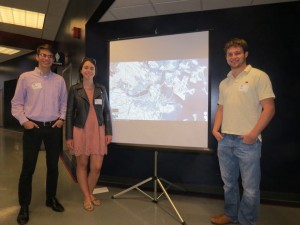Rising Sea Levels: Which Major Cities Could be the Next Atlantis?
By Cole, Dan, Griffin, Madeline, Ryan



Abstract
Upwardly trending temperatures have caused an inordinate amount of melting at the Earth’s poles which has the potential to drastically alter the world’s landscape. Human- environment interactions, including those causing carbon emissions, have a discernible impact on the rate at which climactic changes are occurring. Where in past centuries, ice loss was balanced by winter refreezing, it seems that rising average temperatures have led to an imbalance in this cycle. Ice and snow resting above sea level hold a large amount of water in escrow, yet warming temperatures are sufficient to begin releasing a steady volume of water into the world’s oceans. In addition, warmer seas are subject to thermal expansion and expand as temperatures rise. According to adjusted measurements of the global mean sea-level, the current rate at which the sea is rising has accelerated faster than in the 20th century (Watson et al. 2015). Rising seas are not only an indicator of climate change, but they are also a potentially dangerous side effect. The acceleration of the rate at which the sea is rising due to anthropogenic climate change is debated, however the examination of altimetry data shows that seas are rising faster than they have been ever historically observed (Casenave et al. 2014). The rise in the global mean sea-level between 2000-2009 has been observed as 3.4 ± 0.4 mm/yr, and data indicates that this is higher than observed rates from the previous decade (Nerem et al. 2010; Masters et al. 2012). NASA satellite data since 1993 observes the steady trend of rising sea levels, and although there are few sure indications of future trends, it is generally accepted that seas will continue to rise. According to the United States Global Change Research Program, the 8 inch rise in sea levels between 1880-2014 would be eclipsed by an additional 1-4 feet before 2100 if seas continue to rise at their current variable rates (National Climate Assessment 2014). Although the USGCRP suggests 1-4 feet is most plausible based on current figures, estimates of 6 feet or more could be expected from increasingly elevated effects of anthropogenic climate change (Ibid.; Gregory 2013). According to the data, an estimated 5 million people in America living within 4 feet of sea level at high tide would no longer be able to inhabit their homes by the end of the century (Ibid.). With each 1 Cº rise in temperature, data indicates that the sea would rise over 6 feet as a result (Levermann et al. 2013). This is limited only to the amount of sequestered water in the world’s polar regions, which according to studies could contribute to over 190 feet of rise to the global mean sea-level (Winkelmann et al. 2015). In essence, climate change has the potential to swallow large portions of the world’s land mass, and totally redefine the Earth’s hospitable landscape.
This presentation endeavors to demonstrate the potential consequence of a rise of the global mean sea-level. Major metropolitan areas at low elevation have been selected to show how a continuing trend of rising water might reshape the natural landscape and overtake man made structures. This, of course, would happen at extreme cost to residents and proprietors while also altering the course of those who frequent at-risk areas. As these locations are in major metropolitan areas, the value of property is high and hosts a dense population. Powerpoint slides depicting trends and contingencies will be projected on a loop to display a general overview of rising waters. In addition, observers may request information regarding their area of residence, and its risk of flooding due to rising global mean sea-level.
Bibliography
Cazenave, Anny, Habib-Boubacar Dieng, Benoit Meyssignac, Karina Von Schuckmann, Bertrand
Decharme, and Etienne Berthier. “The Rate of Sea-level Rise.” Nature Climate Change 4 (March
32, 2014): 358-61. doi:10.1038/nclimate2159.
Gregory, Jonathon. Intergovernmental Panel on Climate Change: Projections of Sea Level Rise. Publication no. AR 5. 2013. Accessed March 27, 2016. https://www.ipcc.ch/pdf/unfccc/ cop19/3_gregory13sbsta.pdf.
Levermann, Anders, Peter U. Clark, Ben Marzeion, Glenn A. Milne, David Pollard, Valentina Radic, and Alexander Robinson. “The Multimillennial Sea-level Commitment of Global Warming.” Proceedings of the National Academy of the Sciences of the United States of America
110, no. 34 (June 13, 2013): 13745-3750. doi:10.1073/pnas.1219414110.
Masters, D., R. S. Nerem, C. Choe, Etienne Leuliette, B. Beckley, N. White, and M. Ablain. “Comparison of Global Mean Sea Level Time Series from TOPEX/Poseidon, Jason-1, and Jason-2.” Marine Geodesy 35, no. 1 (April 23, 2012): 20-41. doi:
10.1080/01490419.2012.717862.
Nerem, R. S., D. P. Chambers, C. Choe, and G. T. Mitchum. “Estimating Mean Sea Level
Change from the TOPEX and Jason Altimeter Missions.” Marine Geodesy 33, no. Sup1 (August
16, 2010): 435-46. doi:10.1080/01490419.2010.491031.
United States Global Change Research Program. “Climate Change Impacts in the United States: The Third National Climate Assessment.” National Climate Assessment, 2014. 3rd Assessment. http://s3.amazonaws.com/nca2014/low/ NCA3_Full_Report_02_Our_Changing_Climate_LowRes.pdf?download=1.
“Vital Signs: Sea Level.” Climate Change: Vital Signs of the Planet. Accessed March 27, 2016. http://climate.nasa.gov/vital-signs/sea-level/.
Watson, Christopher S., Neil J. White, John A. Church, Matt A. King, Reed J. Burgette, and Benoit Legresy. “Unabated Global Mean Sea-level Rise over the Satellite Altimeter Era.” Nature Climate Change 5 (May 11, 2015): 565-68. doi:10.1038/nclimate2635.
Winkelmann, Ricarda, Anders Levermann, Andy Ridgwell, and Ken Caldeira. “Combustion of Available Fossil Fuel Resources Sufficient to Eliminate the Antarctic Ice Sheet.” Science Advances 1, no. 8 (September 4, 2015). doi:10.1126/sciadv.1500589.